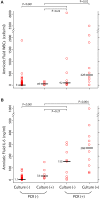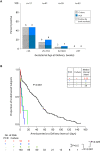Microbial prevalence, diversity and abundance in amniotic fluid during preterm labor: a molecular and culture-based investigation
- PMID: 18725970
- PMCID: PMC2516597
- DOI: 10.1371/journal.pone.0003056
Microbial prevalence, diversity and abundance in amniotic fluid during preterm labor: a molecular and culture-based investigation
Abstract
Background: Preterm delivery causes substantial neonatal mortality and morbidity. Unrecognized intra-amniotic infections caused by cultivation-resistant microbes may play a role. Molecular methods can detect, characterize and quantify microbes independently of traditional culture techniques. However, molecular studies that define the diversity and abundance of microbes invading the amniotic cavity, and evaluate their clinical significance within a causal framework, are lacking.
Methods and findings: In parallel with culture, we used broad-range end-point and real-time PCR assays to amplify, identify and quantify ribosomal DNA (rDNA) of bacteria, fungi and archaea from amniotic fluid of 166 women in preterm labor with intact membranes. We sequenced up to 24 rRNA clones per positive specimen and assigned taxonomic designations to approximately the species level. Microbial prevalence, diversity and abundance were correlated with host inflammation and with gestational and neonatal outcomes. Study subjects who delivered at term served as controls. The combined use of molecular and culture methods revealed a greater prevalence (15% of subjects) and diversity (18 taxa) of microbes in amniotic fluid than did culture alone (9.6% of subjects; 11 taxa). The taxa detected only by PCR included a related group of fastidious bacteria, comprised of Sneathia sanguinegens, Leptotrichia amnionii and an unassigned, uncultivated, and previously-uncharacterized bacterium; one or more members of this group were detected in 25% of positive specimens. A positive PCR was associated with histologic chorioamnionitis (adjusted odds ratio [OR] 20; 95% CI, 2.4 to 172), and funisitis (adjusted OR 18; 95% CI, 3.1 to 99). The positive predictive value of PCR for preterm delivery was 100 percent. A temporal association between a positive PCR and delivery was supported by a shortened amniocentesis-to-delivery interval (adjusted hazard ratio 4.6; 95% CI, 2.2 to 9.5). A dose-response association was demonstrated between bacterial rDNA abundance and gestational age at delivery (r(2) = 0.42; P<0.002).
Conclusions: The amniotic cavity of women in preterm labor harbors DNA from a greater diversity of microbes than previously suspected, including as-yet uncultivated, previously-uncharacterized taxa. The strength, temporality and gradient with which these microbial sequence types are associated with preterm delivery support a causal relationship.
Conflict of interest statement
Figures





References
-
- Lawn JE, Cousens S, Zupan J. 4 million neonatal deaths: when? Where? Why? Lancet. 2005;365:891–900. - PubMed
-
- Goldenberg RL, Rouse DJ. Prevention of premature birth. N Engl J Med. 1998;339:313–320. - PubMed
-
- Simhan HN, Caritis SN. Prevention of preterm delivery. N Engl J Med. 2007;357:477–487. - PubMed
-
- Committee on Understanding Premature Birth and Assuring Healthy Outcomes. Preterm Birth: Causes, Consequences, and Prevention. Washington D.C.: The National Academy Press; 2006.
-
- Green NS, Damus K, Simpson JL, Iams J, Reece EA, et al. Research agenda for preterm birth: recommendations from the March of Dimes. Am J Obstet Gynecol. 2005;193:626–635. - PubMed
Publication types
MeSH terms
Substances
Grants and funding
LinkOut - more resources
Full Text Sources
Other Literature Sources
Medical
Molecular Biology Databases

